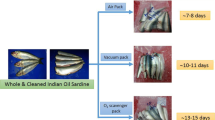Abstract
Squid tubes were packed with 100% (w/w of squid) dry ice (PI), 20% dry ice and 50% water ice (PII) and 50% water ice (PIII) in polyethylene bags and store in thermocole boxes at room temperature (32 ± 2°C) for 24 h. Quality changes curing storage were studied. Lowest temperature of −30.3°C was attained in PI while it was 15–16°C in PII and PIII at 1 h of storage. The gas compositions in packages initially were 21% O2, 0.4% CO2 and 78.1% N2 in PI, PII and PIII, respectively. During storage for 24 h highest level of 82.5% CO2 was noticed in PII. Fresh squid tubes had bacterial flora of Hafnia, Pseudomonas, Bacillus, Flavobacterium and Alcaligens. Hafnia constituted 74% of the flora. Alcaligenes (47%), Alteromonas (30%) and Alcaligenes (56%) were dominant in squid tubes stored in 100% dry ice, in the combination package, and in 100% water ice, respectively. Increase in total volatile base nitrogen and trimethylamine nitrogen, no definite trend in free fatty acid values in all packages while increase in pH in PI and PIII and no consistent changes in PI were noticed during storage for 24 h. The PI had lowest bacterial counts and PIII the highest. Squids stored in PI and PII were sensorily acceptable after 24 and 18 h, respectively.
Similar content being viewed by others
References
APHA (2001) Compendium of methods for the microbiological examination of foods. Downes PF, Ito K (eds), American Public Health Association, Washington DC, p 25–35
Clark DS, Lentz CP (1969) The effect of carbon dioxide and growth of slime producing bacteria on fresh beef. Can Inst Food Technol J 2:72–75
Civera T, Grassi MA, Pattono D (1999) Chemical and microbial characteristics of cephalopods during storage in ice. Industrie Alimentari 38:933–937
Cobb F, Alanoz I, Thompson C (1973) Biochemical and microbial studies on shrimp: Volatile nitrogen and amine nitrogen analysis. J Food Sci 38:431–436
Dalgaard P (2000) Freshness, quality and safety in seafoods. FLAIR-FLOW, Europe Technical Manual F-FE 380A/00. Teagase, The National Food Centre, Ireland
Garg DK, Stephen J (1982) Ice storage studies of kati (Pellona sp.). Fish Technol 19:45–47
Gram LG, Troll A, Huss HH (1987) Detection of specific spoilage bacteria from fish spoiled at low (0°C) and high (20°C) temperature. Int J Food Microbiol 10:303–316
Howgate P (1982) Measurement of deterioration of iced and frozen fish. TD Nr. 564, Torry Research Station, Aberdeen, p 23
Huss HH (1988) Fresh fish; quality and quality changes. FAO Fisheries Series, Nr 29, Italy, p 132
Hobbs G, Hodgekiss W (1982) The bacteriology of fish handling and processing. In: Developments in food microbiology. Davies R (ed), Applied Science Publishers, p 71–117
Jeyasekaran G, Ganesan P, Jeya Shakila R, Maheswari K, Sukumar D (2004a) Dry ice is a novel chilling medium along with water ice for short-term preservation of fish emperor breams, lethirnus (Lethrinus miniatus). J Innovative Food Sci Emerging Technol 5:485–493
Jeyasekaran G, Ganesan P, Jeya Shakila R, Maheswari K, Sukumar D (2004b) Effect of delayed icing on the microbial quality of tropical fish: barracudas (Sphyraena barracuda). J Food Sci 69:197–200
Kreuzer R (1984) Cephalopods: Handling, processing and products. FAO Fisheries Technical Paper Nr 254, p 154
Kyrana VR, Lougovois VP (2002) Sensory, chemical and microbiological assessment of farm-raised European seabass (Dicentratchus labrax) stored in melting ice. Int J Food Sci Technol 37:319–328
Lapa-Guimaraes J, De-Silva MAA, De-Felicio PE, Guzman EC (2002) Sensory, color and psychrotrophic bacterial analyses of squids (Loligo plei) during storage in ice. Lebensm Wissen Technol 35:21–29
Lima dos Santos CAM, James D, Teutscher F 1981. Guidelines for chilled fish storage experiments. FAO Fisheries Technical Paper Nr 210, p 17–21
Moral A, Tejada M, Borderias AJ (1983) Frozen storage behavior of squid (Loligo vulgaris). Revue Internationale du Froid 6: 54–57
Moral A (1987) Metodos fisco- quimicos de control de calidad de pescados. Alimentacian Equipos y Technologia 5:115–122
Macdougall DB (1985) The influence of appearance on the shelf life of meat. J Sci Food Agric 36:122–128
Paarup T, Sanchez JA, Moral A, Christensen H, Bisgaard M, Gram L (2002a) Sensory, chemical and bacteriological changes during storage of iced squid (Todaropsis eblanae). J Appl Microbiol 92:941–950
Paarup T, Sanchez JA, Pelaez C, Moral A (2002b) Sensory, chemical and bacteriological changes in vacuum-packed pressurized squid (Todaropsis eblanae) stored at 4°C. Int J Food Microbiol 74:1–12
Pearson D (1968) Application of chemical methods for the assessment of beef quality. III. Methods related to fat spoilage. J Sci Food Agric 19:553–556
Pires PV, Barbosa A (2004) Sensory, microbiological, physical and nutritional properties of iced whole common octopus (Octopus vulgaris). Lebensm Wissen Technol 37:105–114
Prafulla V, Francis L, Lakshmanan PT (2000) Effect of different methods of icing on the quality of squid and cuttlefish during storage. Fish Technol 37:81–88
Putro S (1989) Dry ice — possible uses in fresh and live fish handling. INFOFISH Int 4:24–25
Ramachandran A, Badonia R, Viswanathan Nair PG (1990) Effect of delayed icing on the microbiological quality of Hilsa toli. Fish Technol 27:30–35
Ruiz-Capillas C, Moral A, Morales J, Montero P (2002) Characterization of non-protein nitrogen in the cephalopods volador (Illex coindetii), pota (Todaropsis eblanae) and octopus (Eledone cirrhosa). Food Chem 76:165–172
Sasi M, Jeyasekaran G, Shanmugam SA, Jeya Shakila R (2000) Chilling of fresh fish in wet and dry ice. Asian Fisheries Sci 13:375–382
Sikorski ZE, Kolodziejska I (1986) The composition and properties of squid meat. Food Chem 20:213–224
Surendran PK, Mahadera Iyer K, Gopakumar K (1985) Succession of bacterial genera during ice of three species of tropical prawns Penaeus indicus, Metapenaeus dobsoni and M. affinis. Fish Technol 22:117–120
Author information
Authors and Affiliations
Corresponding author
Rights and permissions
About this article
Cite this article
Jeyasekaran, G., Jeya Shakila, R., Sukumar, D. et al. Quality changes in squid (Loligo duvaucelli) tubes chilled with dry ice and water ice. J Food Sci Technol 47, 401–407 (2010). https://doi.org/10.1007/s13197-010-0066-5
Revised:
Accepted:
Published:
Issue Date:
DOI: https://doi.org/10.1007/s13197-010-0066-5




